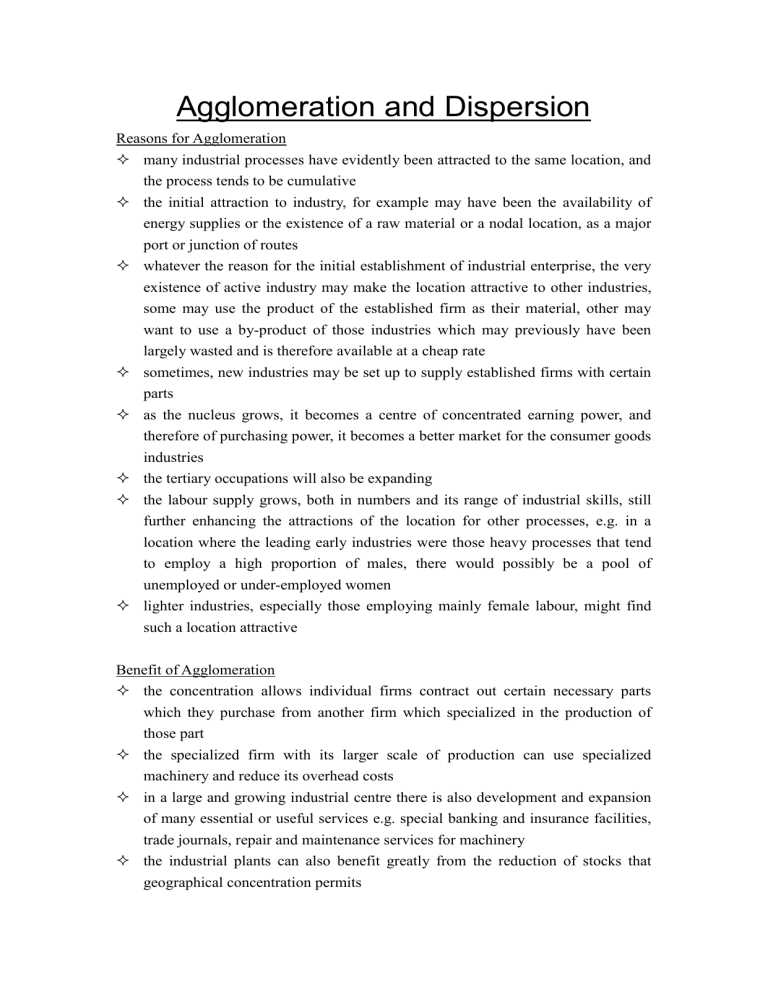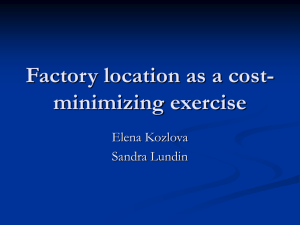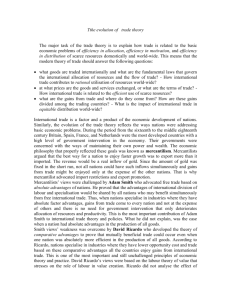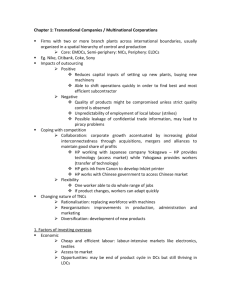Reasons for Agglomeration

Agglomeration and Dispersion
Reasons for Agglomeration
many industrial processes have evidently been attracted to the same location, and the process tends to be cumulative
the initial attraction to industry, for example may have been the availability of energy supplies or the existence of a raw material or a nodal location, as a major port or junction of routes
whatever the reason for the initial establishment of industrial enterprise, the very existence of active industry may make the location attractive to other industries, some may use the product of the established firm as their material, other may want to use a by-product of those industries which may previously have been largely wasted and is therefore available at a cheap rate
sometimes, new industries may be set up to supply established firms with certain parts
as the nucleus grows, it becomes a centre of concentrated earning power, and therefore of purchasing power, it becomes a better market for the consumer goods industries
the tertiary occupations will also be expanding
the labour supply grows, both in numbers and its range of industrial skills, still further enhancing the attractions of the location for other processes, e.g. in a location where the leading early industries were those heavy processes that tend to employ a high proportion of males, there would possibly be a pool of unemployed or under-employed women
lighter industries, especially those employing mainly female labour, might find such a location attractive
Benefit of Agglomeration
the concentration allows individual firms contract out certain necessary parts which they purchase from another firm which specialized in the production of those part
the specialized firm with its larger scale of production can use specialized machinery and reduce its overhead costs
in a large and growing industrial centre there is also development and expansion of many essential or useful services e.g. special banking and insurance facilities, trade journals, repair and maintenance services for machinery
the industrial plants can also benefit greatly from the reduction of stocks that geographical concentration permits
small-scale and specialized industries sometimes also gain great economies by concentrating their activities in a distinctive ‘quarter’ of a large industrial centre e.g. they can buy and sell through local middleman who specialize in their requirement
investment in plant and floor space can sometimes be cut by the practice of
‘putting out’ work for workers to do in their own
the large industrial concentration normally also possesses research organization whose assistance can be called upon
transport services will also be adapted to serve the needs of the industries in an area of major industrial concentration, and firms may obtain special rates because of the large volume of traffic
the labour supply in a large industrial centre is also generally adequate and flexible
Disadvantages of Agglomeration
competition between various industries may bid up the prices of materials and factors of production e.g. labour, land
labour in a regions of heavy industrial concentration is usually strongly unionized
when a region has grown above a certain size, the provision of service and amenities becomes more costly and taxes must be increased to pay for them
congestion increases on existing facilities e.g. transport, water supply, waste disposal services
Strategies for Relocation
some firms look for towns with little or no existing industry, hoping to gain from the lack of competition of labour
some may look for places that already have some industrial potential, hoping to find suitable labour and possible sources of supply for component parts or services
some may look for places with abundant supply of cheap labour
some may look for places with cheap land
some may look for places with more favourable government policy e.g. lower tax rate











